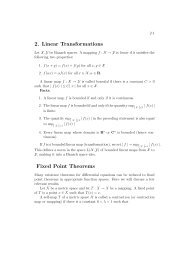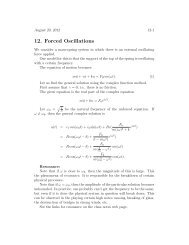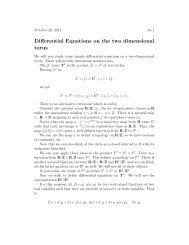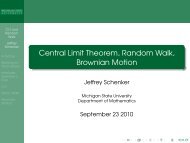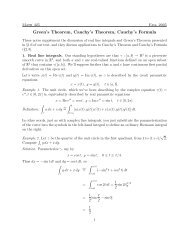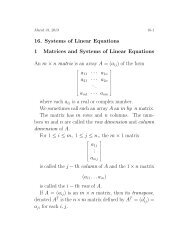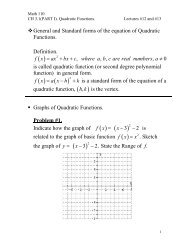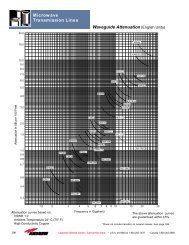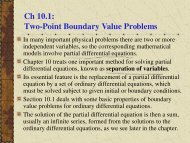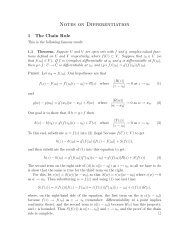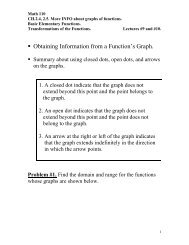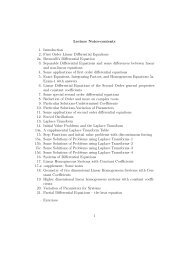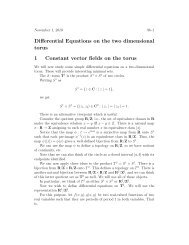Expected Value Homework Solutions 1. You roll two dice. What is ...
Expected Value Homework Solutions 1. You roll two dice. What is ...
Expected Value Homework Solutions 1. You roll two dice. What is ...
You also want an ePaper? Increase the reach of your titles
YUMPU automatically turns print PDFs into web optimized ePapers that Google loves.
Answer: We have the following table for probabilities of when the first heads appears.P (0) = 1/32 The probability that no heads appearP (1) = 1/2P (2) = 1/4P (3) = 1/8P (4) = 1/16P (5) = 1/32.Thus the expected value of what he pays me back <strong>is</strong>0×P (0)+1×P (1)+2×P (2)+4×P (3)+8×P (4)+16×P (5) = 0+1/2+1/2+1/2+1/2+1/2 = 2.5.Thus my expected value <strong>is</strong> $(2.5-2), or 50 cents.1<strong>1.</strong> In the game of birdcage, you pay $1 to play the game. If one of the three <strong>dice</strong> comes up 6, you get$2 back (earning $1). If <strong>two</strong> <strong>dice</strong> come up 6, you get $3 back, and if all three <strong>dice</strong> come up 6, youget $4 back. <strong>What</strong> <strong>is</strong> the expected value of the game?Answer: The probability of no sixes coming up <strong>is</strong> 125216, and in th<strong>is</strong> case you lose $<strong>1.</strong> We next needthe probability of exactly one 6 coming up. Th<strong>is</strong> can happen in one of three ways: the six can beon the first die, the second die, or the third die. For exactly one six, with it on the first die, thereare 1 × 5 × 5 = 25 ways for th<strong>is</strong> to happen. Similarly, there are 25 ways for the six to appear onthe second die, and 25 ways for it to appear on the third die (and for exactly one 6). Thus thereare 75 ways for exactly one six to appear. The value of th<strong>is</strong> outcome <strong>is</strong> $<strong>1.</strong> For exactly <strong>two</strong> sixes toappear, there are 5 ways for the first <strong>two</strong> <strong>dice</strong> to be sixes, 5 ways for the first and the third <strong>dice</strong> tobe sixes, and 5 ways for the last <strong>two</strong> <strong>dice</strong> to be sixes. Consequently there are 15 ways for <strong>two</strong> <strong>dice</strong>to come up six. The value of th<strong>is</strong> outcome <strong>is</strong> $2. Finally, there <strong>is</strong> exactly one way for three sixes tocome up, with a value of $3. Thus the expected value (for you) <strong>is</strong>125 75 15(−1) + (1) +216 216 216 (2) + 1 −17(3) =216 216 .Hence, for every game you play, you expect to lose 7.8 cents.12. The game “Who Wants to be a Millionaire” has $100, $200, $500, $1000, $2000, $4000, $8000,$16000, $32000, $64000, $125000, $250000, $500000, and $1000000 questions. <strong>You</strong> start at the $100levels and work your way up through the questions if you continue to get right answers. Supposeyou got to keep the amount of money of your last correct question (which <strong>is</strong>n’t what happens inthe show). Each question <strong>is</strong> multiple choice with 4 possible answers, only one of which <strong>is</strong> correct.<strong>What</strong> <strong>is</strong> the expected amount of money that a contestant would get if they guess randomly on eachquestion?Answer: We have the following probabilities for money amounts



